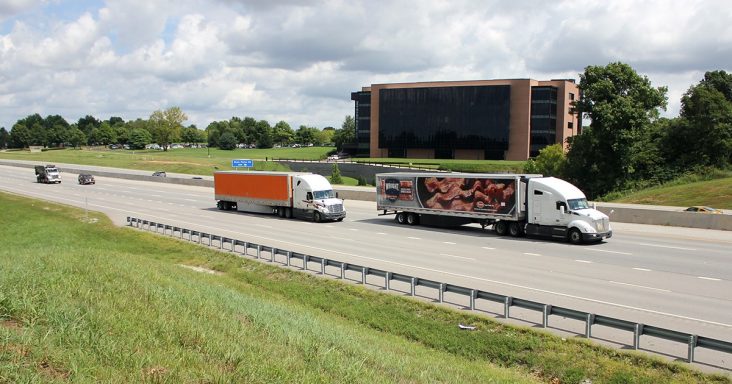Freight market continues to show strength; carriers increase driver pay
by June 7, 2021 12:53 pm 1,131 views

Trucking capacity has remained tight, and rates have been at record highs as carriers boost driver pay.
In a recent Convoy webinar, Aaron Terrazas, director of economic research for the third-party logistics company, said he expects the market strength to continue through the end of the year.
“The freight market continues to be exceptionally strong,” Terrazas said, adding that “rates [are] … holding at record highs. I can’t emphasize enough what a radical departure this is from what the industry expected from a few months ago. In December and January, the consensus was squarely on this idea that the market on the cusp of cooling. That hasn’t happened. Instead, the opposite has happened.”
Terrazas said the world is in a different place from where it was six months ago and that the COVID-19 vaccine rollout has gone better than expected. Several unknowns remain concerning the economy, he said, but the market is expected to remain elevated through 2021.
Truck orders are high and close to past peaks and are high relative to driver availability, he said. Truck delivery lag recently exceeded more than 12 months in a tight labor market. The solution to the latter has been to increase pay, and carriers have been doing this.
Van Buren-based USA Truck Inc. announced Monday (June 7) that dedicated driver pay would increase to $104,000 annually in select markets.
“It is great to see our company continue to improve the lives of our employees, customers and shareholders,” said Tim Guin, executive vice president and chief commercial officer for USA Truck. “There is a direct correlation of competitive pay to attract and retain team members with service and profitability. Our team is focused on providing capacity solutions to our customers by bringing top drivers into our organization. We are pleased to announce this driver salary increase.”
In May, USA Truck increased pay for the first time since 2018, according to a FreightWaves article. The carrier’s May announcement showed it made “numerous improvements to driver compensation in 2021” and that “drivers will receive a higher rate per mile with no qualifiers, bonuses or mileage bands.”
Also in May, North Little Rock-based Maverick Transportation LLC announced its second driver pay increase this year. Pay rose between 3 and 4 cents per mile for flatbed and glass over-the-road drivers. Dedicated division pay also rose up to 5 cents per mile.
“Our drivers have worked extremely hard during these unprecedented times of high demand and tight capacity, and we are proud to recognize them with this industry-leading pay package,” said John Culp, president of Maverick Transportation.
In March, Tontitown-based carrier P.A.M. Transportation Services Inc. increased pay for over-the-road drivers by up to 45 cents per mile, according to a company blog post. The carrier also offered multiple bonuses, including one for mentors.
Freight volumes moderated in April after rising to a five-month high in March, according to Tim Denoyer, vice president and senior analyst for ACT Research. Denoyer also is the author of the Cass Freight Index.
“Some of the strength was make-up for the polar vortex-impacted February level, but this slower growth also likely reflects ongoing supply constraints and the deepening semiconductor shortage,” he added. “And with both driver and equipment capacity in short supply, we are witnessing the strongest rate environment in survey history, even with a bit slower volumes.”
The market is expected to continue to remain tight, but increased services spending could lead to more moderation in freight demand. And the end of extended unemployment insurance is expected to help driver availability improve, he noted.
Terrazas said he expects some of the hiring challenges to be partially offset by improved efficiency. A metric he’s closely following is the labor workforce participation rate, which has remained low. It’s not returned to the expected level, and this past year might have led people to reevaluate the tradeoffs between labor and leisure. If workers don’t return as expected, this could impact long-term growth projections.
In a recent industry update, senior research analyst Garrett Holland of Baird said the fading stimulus money is expected to be a headwind to the industry as economic growth moderates and the mix of consumer spending starts to become more normal. The decline in benefits is expected to impact economic growth in 2022 and 2023. The stimulus accounted for 3% to 4% of GDP growth.
“Aggressive fiscal stimulus during the pandemic has supported the recovery, but this stimulus-induced growth is not likely sustainable and has arguably pulled forward demand,” Holland said. “As the economy fully re-opens, look for the mix of consumer spending to rebalance away from goods-oriented consumption back to experiences such as travel and entertainment, which could contribute to moderating freight demand.”
